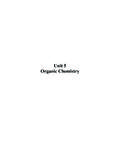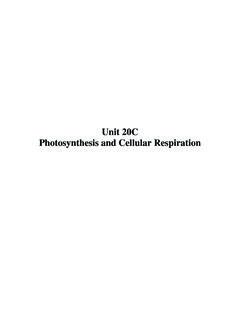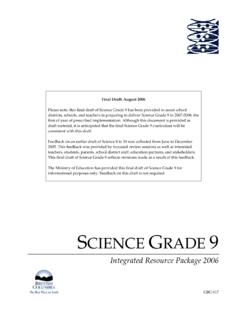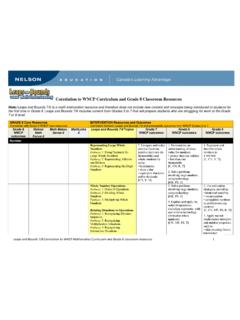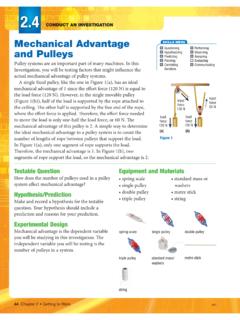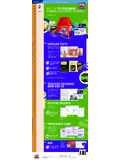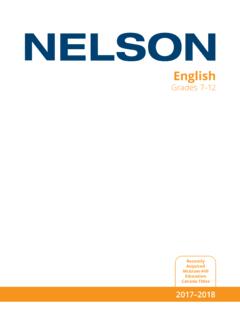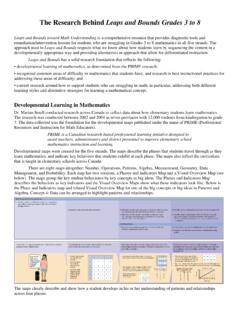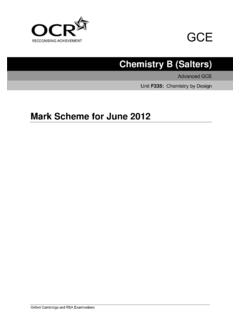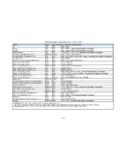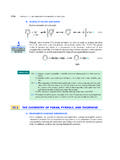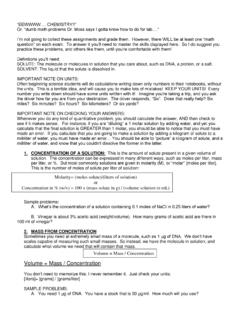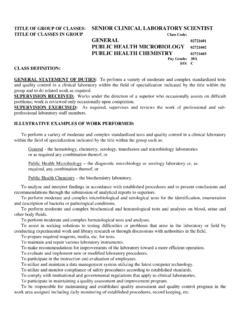Transcription of Unit 1 Chemical Bonding – Explaining the Diversity …
1 unit 1 Chemical Bonding Explaining the Diversity of Matter 11unitWinter in Alberta! While the snowboard, the clothing, and the energy all come fromchemical reactions, the fun depends largely on the way water behaves when solid. Thismost common of substances has properties unlike any other; for example, waterexpands upon freezing, and ice liquefies momentarily under pressure. These prop-erties help make skiing, snowboarding, skating, and sledding , Explaining , and predicting the nature and behaviour of substances isfundamental to chemistry. Inquiring scientists assumed there must be a reason whythe complex structures of snowflakes always have hexagonal symmetries, and theyapplied scientific inquiry and techniques to find a plausible theory.
2 When their ini-tial theory also worked to describe many other properties of water, scientists consid-ered the theory more valid. When scientists found the theory to be useful in predictingthe properties of many other substances, it became generally accepted within thescientific community. All theories develop in this way: we constantly test them againstwhat we know of the real world. When such testing eventually produces conflictingevidence, a theory is restricted,or revised, or perhaps even replaced, resulting in anewer theory that is better able to describe,explain, and predictwhat we knowledge-gathering process of science really has only two fundamental rules:theories must be based on reliable evidence, and theories must be tested for accuracywhenever theories assume that an understanding of how substances behave dependson understanding how the tiniest units of matter are held together.
3 In addition,understanding Chemical change always depends on the concept of breaking bondsand forming new ones. In this unit , you will study Chemical Bonding the conceptof forces that hold atoms, ions, and molecules together and the relationship ofthese bonds to the properties and structure of you progress through the unit , think about these focusing questions: Why do some substances dissolve easily while others do not? Why do different substances have widely different melting and boiling points? How can models increase our understanding of invisible things such as bonds?72 unit 1 NELC hemical Gonding Explaining theDiversity of MatterChemical Bonding Explaining theDiversity of MatterUnit 1 - Ch 03 Chem20_new 11/3/06 8:23 AM Page 72 GENERAL OUTCOMEIn this unit , you will describe the roles of modelling, evidence,and theory used in Explaining andpredicting the structure, chemicalbonding, and properties of ionic andmolecular substancesChemical Bonding Explaining the Diversity of Matter73 NELUnit2 unit 1 - Ch 03 Chem20_new 11/3/06 8:23 AM Page 73 unit 1 ChemicalBonding Explaining theDiversity ofMatterARE YOU READY?
4 74 unit 1 NELT hese questions will help you find out what you already know, and what you need toreview, before you continue with this According to a chemistry classification system, each of the following statementsapplies only to elements or only to be decomposed into simpler substances by Chemical of two or more kinds of atomsiii. can be decomposed into simpler substances using heat or electricityiv. composed of only one kind of atom(a) Which statements apply only to elements?(b) Which statements apply only to compounds?(c) Which statements are empirical?(d) Which statements are theoretical? 2. Describe the atomic models presented by each of the following:(a) J.
5 J. Thomson(b) Ernest Rutherford(c) John Dalton3. Provide the labels, (a) to (e), for Figure 1to describe an atom. In addition to thename, provide the international symbol for the three subatomic Copy Table 1, and complete it using the periodic table and atomic Niels Bohr explained the periodic law and line spectra by creating the Bohrmodel of the atom. Draw energy-level diagrams to describe the following atoms:(a) nitrogen, N(b) calcium, Ca(c) chlorine, ClConcepts ionic and molecularcompounds atomic structure formation of ions nature and strength ofelectrostatic forces relationship between lawsand theories Skills laboratory safety rulesYou can review prerequisiteconcepts and skills in theChemistry Review unit and inthe unit Pre-Test is alsoavailable (a)(b)(c)(d)(e)Figure 1An atom model, as used to represent an atom(very simplistically) in the 1930sTable 1 Components of Atoms and IonsEntityNumber of protonsNumber of electronsNet chargehydrogen atomsodium atomchlorine atomhydrogen ionsodium ionchloride 1 - Ch 03 Chem20_new 11/3/06 8.
6 23 AM Page 74 Unit1 Chemical Bonding Explaining the Diversity of Matter75 NEL6. Compounds can often be classified, based upon empirical definitions, as ionic ormolecular. Copy and complete Table 2, indicating the properties of Classify compounds according to the following empirical properties as ionic,molecular, or either:(a) high solubility in water; aqueous solution conducts electricity(b) solid at SATP; low solubility in water(c) solid at SATP; low melting point; aqueous solution does not conduct electricity8. According to atomic and Bonding theories, atoms react by rearranging theirelectrons.(a) Silicon tetrafluoride is used to produce ultra-pure silicon wafers (Figure 2).
7 Draw an energy-level diagram for each atom or ion in the following wordequation for the formation of silicon tetrafluoride:silicon fluorine silicon tetrafluoride(b) Calcium fluoride occurs naturally as fluorite (pure compound) and asfluorspar (mineral,Figure 3). Calcium fluoride is the principal source of theelement fluorine, and is also used in a wide variety of applications such asmetal smelting, certain cements, and paint pigments. Draw an energy-level diagram for each atom or ion in the following word equation for theformation of calcium fluoride:calcium fluorine calcium fluoride(c) What is the difference in the electron rearrangement in (a) compared with (b)?9. What is the difference between a scientific law and a scientific theory?
8 10. In the progress of chemistry, what generally comes first, laws or theories?Skills11. What document provides information about safe handling and safe disposal of achemical?12. If a corrosive Chemical comes in contact with your skin, what is the normalprocedure to follow? 13. List two items common to school labs that should routinely be worn forpersonal protection against Chemical List three types of general safety equipment common to school chemistry When evaluating a scientific theory or concept, what three basic criteria areused?Table 2 Properties of Ionic and Molecular CompoundsClasses ofPropertiesClass ofelementsMelting pointState at SATPE lectrolytescompoundinvolved (high/low)(s, l, g)(yes/no)ionicmolecularFigure 2In 1972, Intel s 8008 computerprocessor had 3500 transistors.
9 By2000, the Pentium 4 processor had42 million transistors on a 3 Fluorspar is a mineral that can befound in many countries. It takes avariety of colours and has differentproperties, depending 1 - Ch 03 Chem20_new 11/3/06 8:24 AM Page 7533 UnderstandingChemical CompoundschapterUnderstandingChemical Compounds76 Chapter 3 NELWhen enough atoms or molecules bond to each other, they must eventually form aquantity of substance that is big enough for a human to detect and measure. The com-pound shown crystallizing from solution in Figure 1illustrates this you study this chapter, you will follow much the same sequence of ideas as chemistsdid in the early 1900s. As some chemists refined atomic structure theory, others devel-oped ideas about how atoms bond to each other.
10 Initial Bonding theories were restrictedto simple ionic and molecular compounds, but expanded over time through constant ques-tioning and testing. All theories are considered to be only as good as their ability to accu-rately describe, explain, and predict phenomena. Eventually, Bonding theory becamehighly sophisticated, allowing structural descriptions of very complex substances. Bondingtheory development is a good example of the cyclical nature of science. Curiosity aboutinitial observations leads to creation of theory, which is then used to describe, explain,and predict new observations. The new observations in turn may require better theoriesfor a more complete explanation.
